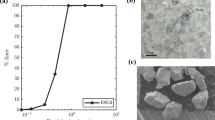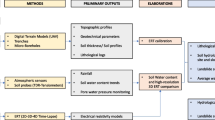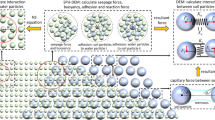Abstract
Backward erosion piping is an important failure mechanism in both dikes and dams where sandy layers are covered by a cohesive layer. Shallow pipes are formed at the interface of the sandy or silty layer and the cohesive cover layer. As a pipe is formed, a zone of disturbed sand grains forms around it, which may have an effect on the equilibrium of forces on the grains at the tip and walls of the pipe. This study focuses on the size and hydraulic conductivity of the disturbed zone, and its impact on pipe progression. Experiments were conducted with a range of sand types, to investigate the process of disturbed zone formation at the grain scale. A camera was used to record the process of pipe formation from above. Images captured during pipe development were analysed to obtain displacement fields for particles in front of the pipe tip, and to determine the size and degree of looseness of the disturbed zone there. The hydraulic conductivities of the disturbed soils were estimated based on the displacement of sand grains. An algorithm was derived to calculate the hydraulic head distribution in front of the pipe tip, taking the disturbed zone into consideration. Based on this, the effect of the disturbed zone on the hydraulic conditions near the pipe tip was analysed. The findings of the study are essential to properly understanding the backward erosion mechanism.












Similar content being viewed by others
References
Van Beek VM, Knoeff HG, Schweckendiek T (2011) Piping: over 100 years of experience: from empiricism towards reliability-based design. A feeling for soil and water: A tribute to prof. Frans Barends, 2011, Deltares Select Series 7
Dong ZR (1999) Practical technology of emergency repair of levees. China Water Power Press, Beijing
Bligh WG (1910) Dams, barrages and weirs on porous foundations. Eng News 64(26):708–710
Lane EW (1935) Security from under-seepage-masonry dams on earth foundations[C]. In: Proceedings of ASCE
Richards KS, Reddy KR (2012) Experimental investigation of initiation of backward erosion piping in soils. Géotechnique 62(10):933
Van Beek VM, Bezuijen A, Sellmeijer JB et al (2014) Initiation of backward erosion piping in uniform sands. Geotechnique 64(12):927–941
Miesel D (1978) Rückschreitende erosion unter bindiger Deckschicht. Baugrundtagung, Berlin
Müller-Kirchenbauer H (1980) Zum zeitlichen Verlauf der ruckschreitenden erosion in geschichtetem Untergrund unter Dammen und Stauanlagen. Schriftenreihe des deutschen Verbandes fur Wasserwirtschaft und Kulturbau
Townsend FC, Schmertmann JH, Logan TJ et al (1981) An analytical and experimental investigation of a quantitative theory for piping in sand. Final Report, University of Florida
Pietrus T J. An experimental investigation of hydraulic piping in sand. University of Florida, 1981
Hanses UK (1985) Zur Mechanik der Entwicklung von Erosionskanälen in geschichtetem Untergrund unter Stauanlagen. Universitätsbibliothek der TU Berlin
De Wit JM (1984) Onderzoek zandmeevoerende wellen Rapportage Modelproeven. CO-220887/10. Delft, the Netherlands: Grondmechanica Delft. (in Dutch)
Silvis F (1991) Verificatie piping model: proeven in de deltagoot. Delft, the Netherlands: Grondmechanica Delft. (in Dutch)
Van Beek VM, Van Essen HM, Vandenboer K et al (2015) Developments in modelling of backward erosion piping. Géotechnique 65(9):740–754
Van Beek VM (2015) Backward erosion piping: initiation and progression
Wang LF, Cao DL (1991) Study of piping failure in Jingjiang dike foundation. J Yangtze River Sci Res Inst 8(2):44–51 (in Chinese)
Mao CX, Duan XB, Cai JB et al (2004) Experimental on harmless seepage piping in levee foundation. J Hydraul Eng 35(11):46–53 (in Chinese)
Yao QL, Ding LQ, Sun YD et al (2007) Experimental studies on piping in single- and two-stratum dike foundations. Water Resour Hydropower Eng 38(2):13–18 (in Chinese)
Schmertmann JH (2000) The no-filter factor of safety against piping through sands. In: Judgment and innovation: the heritage and future of the geotechnical engineering profession, pp 65–132
Sellmeijer JB (1988) On the mechanism of piping under impervious structures
Sellmeijer H, de la Cruz JL, van Beek VM et al (2011) Fine-tuning of the backward erosion piping model through small-scale, medium-scale and IJkdijk experiments[J]. Eur J Environ Civil Eng 15(8):1139–1154
Stanier SA, Blaber J, Take WA et al (2015) Improved image-based deformation measurement for geotechnical applications. Can Geotech J 53(5):727–739
Kozeny J (1927) Über kapillare leitung des wassers im boden:(aufstieg, versickerung und anwendung auf die bewässerung). Hölder-Pichler-Tempsky
Cao H, Xiao YP (2016) Experimental study of permeability characteristics of top soil at free face during the progression of seepage deformation. Rock and Soil Mechanics, (in Chinese)
Acknowledgements
The financial support provided by The State Key Laboratory of Subtropical Building Science is gratefully acknowledged. The thoughtful comments from anonymous reviewers and the editors are appreciated.
Author information
Authors and Affiliations
Corresponding author
Additional information
Technical Editor: Paulo de Tarso Rocha de Mendonça.
Rights and permissions
About this article
Cite this article
Xiao, Y.P., Cao, H. & Zhai, C. Analytical and experimental investigation of a disturbed zone around a pipe in sand. J Braz. Soc. Mech. Sci. Eng. 40, 238 (2018). https://doi.org/10.1007/s40430-018-1160-2
Received:
Accepted:
Published:
DOI: https://doi.org/10.1007/s40430-018-1160-2




